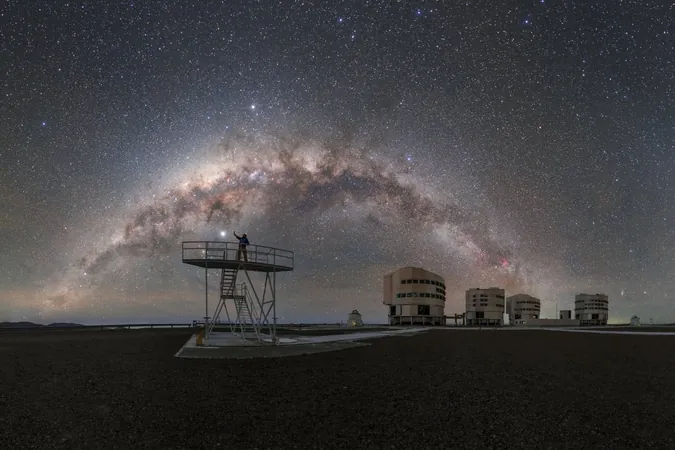
Major Industrial Proposal Puts Chile's Premier Astronomical Site at Risk!
2025-01-09
Author: Lok
The European Southern Observatory (ESO) has issued a grave warning about the consequences of a proposed industrial complex that threatens to disrupt the pristine skies above its Paranal Observatory in Chile's Atacama Desert. This location is renowned for offering some of the clearest views of the universe—a critical asset for astronomical research.
The Inna Project: An Industrial Giant Rising Next Door
Dubbed the Inna project, this ambitious initiative, proposed by AES Andes—a subsidiary of a major U.S. power company—plans to establish an industrial-scale green hydrogen facility. Encompassing over 7,413 acres, the project would include not just hydrogen production plants but also a port and thousands of electric generators, all situated a mere 3 to 7 miles (5 to 11 kilometers) from the VLT. The Environmental Impact Assessment for this project was filed with Chilean authorities just last month.
Environmental concerns are already casting shadows over AES Andes' claims of community and environmental stewardship. Paranal Observatory officials have voiced their worries that the industrial activities could diminish the clarity and effectiveness of their observations, forever tarnishing one of the world’s paramount sites for astronomical inquiry.
The Atacama Desert: A Rare Jewel for Astronomy
The Atacama Desert benefits from exceptional atmospheric conditions, offering astronomers some of the darkest and clearest skies on Earth. Its high elevation and minimal moisture provide optimal conditions for stargazing, eliminating much of the atmospheric turbulence that plagues other observatories worldwide. This unique environment has allowed the VLT to make significant astronomical discoveries—from imaging asteroids to observing the aftermath of NASA’s recent DART mission, which aimed to deflect an asteroid’s trajectory.
In addition to the VLT, the Atacama houses several other world-class observatories, including the upcoming Giant Magellan Telescope and the Rubin Observatory, which boasts the largest digital camera globally. The region’s astronomical significance cannot be overstated, making any disruption a cause for global alarm.
Light Pollution: A Brewing Crisis
Research has shown that light pollution, already a growing issue for many observatories, may worsen considerably if the Inna project progresses. A study highlighted that light pollution over Paranal is currently lower than that at most major observatories, but it remains on the rise—an alarming trend that compromises astronomical research. The ESO warns that if unchecked, light pollution could severely degrade our capacity to explore outer space.
Compounding this issue is the challenge posed by satellite constellations like SpaceX's Starlink, which create streaks across the night sky, complicating observations even for space-based telescopes. The Earth’s night sky is growing increasingly unrecognizable, with projections that it is brightening by nearly 10% annually, reducing the visibility of some of the dimmer celestial objects.
A Call to Action
Xavier Barcons, ESO’s Director General, has called for immediate action, stating, “The proximity of the AES Andes industrial megaproject to Paranal poses a critical risk to the most pristine night skies on the planet.” Barcons emphasized the urgent need for alternative locations for the industrial complex to preserve the heritage and integrity of astronomical research.
The Extremely Large Telescope, set to be the world's largest visible and infrared light telescope, is also under threat. Its expected launch in 2028 could coincide with the decline of Paranal’s observational capabilities if the Inna project moves forward.
The ESO advocates for the relocation of this project, stressing that preserving the skies over Paranal is essential for humanity's quest for knowledge about the universe. While AES Andes promotes the project as a green energy solution, critics argue there’s a painful irony in sacrificing the environment for a project aiming to benefit it.
As humanity continues to seek sustainable energy sources and solutions to pressing environmental issues, the fate of astronomical research hangs in the balance. Will authorities heed the call and protect one of mankind's most significant scientific legacies, or will a new era of light pollution dim our understanding of the cosmos? Only time will tell.

 Brasil (PT)
Brasil (PT)
 Canada (EN)
Canada (EN)
 Chile (ES)
Chile (ES)
 Česko (CS)
Česko (CS)
 대한민국 (KO)
대한민국 (KO)
 España (ES)
España (ES)
 France (FR)
France (FR)
 Hong Kong (EN)
Hong Kong (EN)
 Italia (IT)
Italia (IT)
 日本 (JA)
日本 (JA)
 Magyarország (HU)
Magyarország (HU)
 Norge (NO)
Norge (NO)
 Polska (PL)
Polska (PL)
 Schweiz (DE)
Schweiz (DE)
 Singapore (EN)
Singapore (EN)
 Sverige (SV)
Sverige (SV)
 Suomi (FI)
Suomi (FI)
 Türkiye (TR)
Türkiye (TR)
 الإمارات العربية المتحدة (AR)
الإمارات العربية المتحدة (AR)